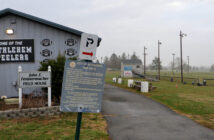Lehigh students and professors across colleges are conducting virtual reality research to enhance health, cognitive function and communication.
A team of seven students in the integrated business and engineering program discovered a new way to diagnose the early onset of glaucoma, a common eye disease that causes damage to the optic nerve. The team presented its capstone project to professors, experts, sponsors and fellow students in December 2017.
John St. Pierre, ’18, Alli Rubin, ’18, Winston La, ’18, Bryce Macomber, ’18, David Morency, ’18, Sam Presti, ’18, and Zhuojie Ji, ’18, worked alongside their mentor, Gordon Campbell, to create their product. Pat Costa, the IBE senior capstone design program professor, and Avani Shah, an Allentown ophthalmologist, also helped the students throughout the process.
“Some groups start with a product, some groups start with an idea,” Rubin said. “We were one of the groups that started with an idea. We met Shah who had this crazy idea. She basically said, ‘Hey, my nephew has a virtual reality headset. I have a big machine in my office. Is there any way that these two could work together?’”
The team conducted research on different eye diseases to see if virtual reality could play a role in ophthalmologic diagnoses. Once they established the viability of the idea, the students began to build a prototype.
The virtual reality set they had needed to be altered with coding and a third-party software.
“We needed something called eye-tracking in order for our prototype to do its job, and it’s not very prominent in the U.S. yet,” Rubin said. “A lot of 3-D coding was needed, which was tough because not a lot of Lehigh students have experience with that.”
Macomber said rapidly changing technology will positively affect future prototypes. New technology made available in 2017 helped the team implement eye-tracking into its prototype.
“One of our goals in creating this prototype was to make the glaucoma test available to all individuals, regardless of financial restrictions,” Morency said. “We were really lucky to have this opportunity.”
The students created their prototype in the Virtual Reality Lab in Fairchild-Martindale Library. According to the LTS website, the lab maintains virtual reality headsets that are designed to use “room-scale technology to turn a room into a 3-D ‘virtual world’ space.”
Lehigh faculty are also experimenting with virtual reality in different settings.
Scott Garrigan, a professor in the College of Education, has already found ways to incorporate virtual reality headsets into classrooms.
In spring 2017, Garrigan completed research at Centennial School, a private school staffed by Lehigh faculty and graduate students in Bethlehem. He studied how the immersion of virtual reality can help primary school students with disabilities improve their focus, specifically in reading.
Garrigan said he worked with students between 11 and 12 years old. He said he divided students into two groups, one of which was a control group where students were not fully immersed in the virtual reality experience. The other group was fully immersed into virtual reality.
“It’s a little early to give out the official statistical data from this experiment,” Garrigan said. “But from observation, it looked like there was improved focus with those students fully immersed in the VR experience. Whether or not VR is feasible in every traditional classroom setting is a different discussion.”
Garrigan said he expects statistical data to be made available in April. He also plans to conduct a similar experiment with older students later in the year.
Jeremy Littau, a professor of journalism and communication, teaches a multimedia storytelling class which relies heavily on 360-degree photo and video software and virtual reality. He said he is confident this new technology will change the world of journalism.
“Virtual reality is about taking someone inside of an intense experience,” Littau said. “It’s an empathy engine, which is crucial to effective storytelling.”






Comment policy
Comments posted to The Brown and White website are reviewed by a moderator before being approved. Incendiary speech or harassing language, including comments targeted at individuals, may be deemed unacceptable and not published. Spam and other soliciting will also be declined.
The Brown and White also reserves the right to not publish entirely anonymous comments.
1 Comment
Very interesting…I would love to start some communications between these Lehigh students and our high school students at Tampa Preparatory School. They seem to share the same passion for virtual reality creation. Our students have already created 2 vr apps for the Oculus Rift made in Unity 3d and C#. Here’s a link to one of the students explaining his project. https://youtu.be/vaeI0mH5W5Y